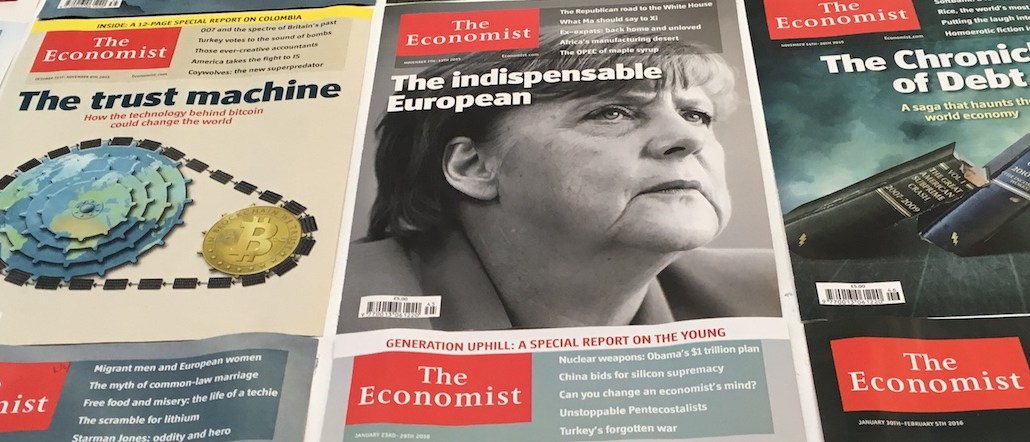Save 50% on a 3-month Digiday+ membership. Ends Dec 5.

Snapchat is bringing more serious news to its Discover section, adding a new channel from The Economist this weekend.
The channel will publish 14 to 17 snaps each weekend, telling business, politics, science and technology stories through a mix of graphics, video, animation and text. Its weekend publishing schedule is another sign that Snapchat is getting more flexible with publishing frequency. The first Discover partners, including People and CNN, were posting content on a daily basis. Since then, there have been popup channels like Seventeen Prom from Hearst, occasionally appearing channels from Vox Media’s eight verticals and others that don’t publish daily, including Vogue’s (which publishes Tuesdays and Fridays) and We the People (Sunday through Thursday).
For Snapchat, having variety of publishing frequency lets it promote a range of content in an increasingly crowded Discover section that also features Lives Stories from events and geographic locations.
For The Economist, posting once a week lets it have a presence there without overly taxing its staff. While some publishers have had to create dedicated teams — of as many as 10 people, in MTV’s case — to feed Snapchat’s needs, The Economist has four people on Snapchat, only two of whom are dedicated to the channel for now.
What does a 173-year-old newspaper look like on @Snapchat Discover? Find out this weekend! pic.twitter.com/TLIrUQJ3qq
— The Economist (@TheEconomist) October 7, 2016
The Economist might seem to be a curious addition to Discover, since the highbrow news brand isn’t the first thing people might associate with Snapchat’s young user base and playful nature. Snapchat claims it reaches 41 percent of 18- to 34-year-olds in the U.S. Other publishers on Discover include MTV, Cosmopolitan and BuzzFeed. But the addition of The Wall Street Journal in January was a strong sign that Snapchat is interested in a broad array of content. Snapchat’s audience will age as it grows, and a publication like The Economist could help Snapchat appeal to older users.
In a statement, Nick Bell, vp of content for Snap, Snapchat’s parent, referred to The Economist’s respected editorial voice, saying, “we’re thrilled that they’ll be introducing their content to the Snapchat community through in-depth coverage of some of the most important issues we face, from the future of our global economy to foreign policy and culture.”
The Economist actually has a younger audience than some of its peers do, perhaps owing to its witty tone and its strong college readership. Its median reader age in print is 48, compared to the Journal’s 55 and Businessweek’s 48.8, according to GfK MRI.
For The Economist, being on Snapchat gives it a way to promote itself to people who don’t know or misunderstand it. Reader revenue is a cornerstone of The Economist’s business model and right now, Snapchat doesn’t give publishers a way to promote subscriptions. But clearly The Economist still sees value in being there, similar to the way it uses Facebook and Twitter as an awareness-building effort.
“This is a really good way to challenge the problem we have,” said Tom Standage, deputy editor of The Economist. “In the U.S., 60 percent haven’t heard of us at all, and among the 40 percent who have, there’s a misperception that all we care about is economics and finance. This is a way for us to reach an audience we might not otherwise reach and say, ‘Look, it’s not all economics and finance.’”
More in Media

AI-powered professional learning and the battle vs. ‘workslop’: Inside Deloitte’s Scout
Deloitte last month launched Scout as part of its Project 120, the company’s $1.4 billion investment in professional development.

‘The Big Bang has happened’: Reach gets proactive on AI-era referrals, starting with subscriptions
This week, the publisher of national U.K. titles Daily Mirror, Daily Express and Daily Star, is rolling out its first paid digital subscriptions – a big departure from the free, ad-funded model it’s had throughout its 120-year history.

Arena Group, BuzzFeed, USA Today Co, Vox Media join RSL’s AI content licensing efforts
Arena Group, BuzzFeed, USA Today Co and Vox Media are participating in the RSL Collective’s efforts to license content to AI companies.





